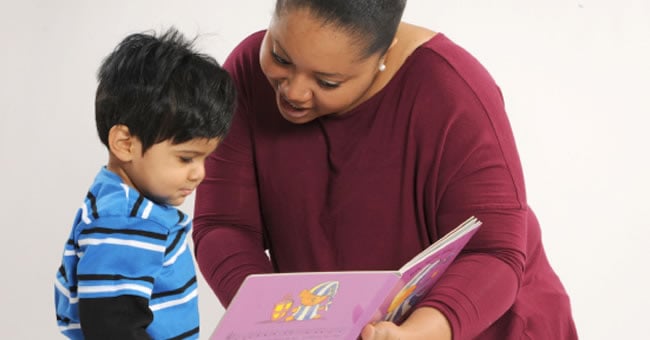
Storytime is an integral part of early childhood care and education settings. It helps children learn to love reading at an early age and helps them gain the basic skills needed to develop more advanced literacy skills later in life. In their book Time for a Story, Amy Brooks Read and Saroj Nadkarni Ghoting emphasize that storytimes for infants and toddlers need to be flexible and that young children should always have the choice of participating. They also discuss the format of storytimes and offer some great tips to keep in mind as you're planning them:
An Effective Storytime Format
Storytimes for infants are usually much shorter and less formal than storytimes for toddlers. The sample format featured below is for toddler storytimes and is featured in Read and Ghoting's Time for a Story:
- Opening Rhyme or Song – Choose a song or rhyme to begin storytime with each time.
- Introduction – Start by telling children what's happening. "It's time to read books!" or "Today we are going to read about _______."
- Two to Four Songs or Rhymes – You'll need to adjust the number for your age group. Repeat the songs or rhymes a couple of times so the children can begin to learn them. You can clap once between each song and/or rhyme to indicate that it's over. Depending on your group's abilities and interest, try mixing up action rhymes with quieter ones. You can also add puppets or story gloves to maintain children's interest.
- Read One Book – Now that children are more focused, read one book to the children.
- Two to Four Songs or Rhymes – Remember to adjust the number of songs and rhymes to meet the needs of your group. You should also use this time to get your next book ready, so you can avoid any waiting time.
- Read One Book – Consider switching to a different type of book. For example, you may want to read a book with a different format, such as a big book, a lap-size book, or a hardcover book. Another option is to read a book from a different category, such as a storybook or information book.
- Use a Flannel Story, Puppet, or Story Glove – All of these can be used to help you tell a story, sing a song, or reinforce topics and concepts. You may also want to use additional props, such as music, blocks, scarves, musical instruments, or other materials that are represented in the books you have read during storytime.
- Closing Song or Rhyme – Be sure to close with the same song or rhyme each time.
Tips for Planning Effective Storytimes
Once you've figured out your format, use these tips from Read and Ghoting to ensure you're planning the best storytimes possible for the young children in your care:
- Choose books that you like to read. Remember, repetition is good, so reread books that you and the children like.
- Determine what your purpose is. Why did you choose this particular song or book? What do you want to accomplish? Having fun and enjoying books is a great goal!
- Practice, read the book through, and plan what you would like to do with it during storytime. Do you want to sing the book, add props, tell a story about it, retell it after reading, etc.?
- Make sure to gather all of the items you will need for storytime before it begins.
- Plan and write down the vocabulary you want to introduce, questions you want to ask, and words to the new songs you are going to sing. Be sure to also write down any other special notes or reminders.
- If needed, gather additional information about the topic(s) you're going to cover during storytime. The Internet, resource books, your local library, and your colleagues are all great sources of information.
- After storytime, review and reflect on what worked well and what could be improved. Were the children interested? Why or why not?
- You can also challenge yourself by asking another teacher or staff member to observe your storytime and give you some feedback.
Be sure to browse our selection of children's books for a variety of wonderful books for infants and toddlers.
